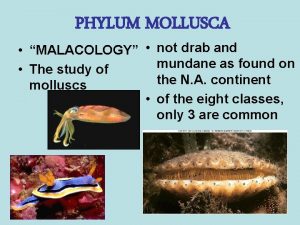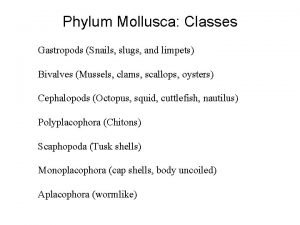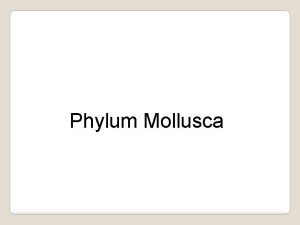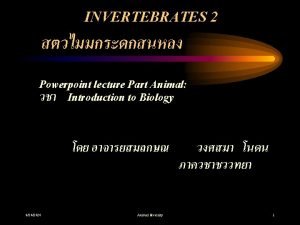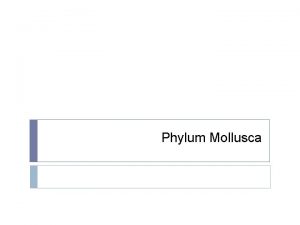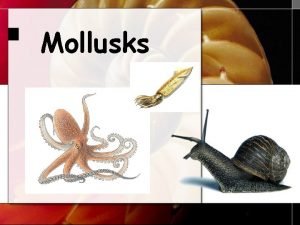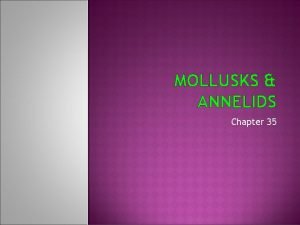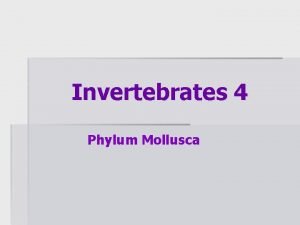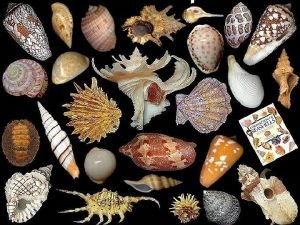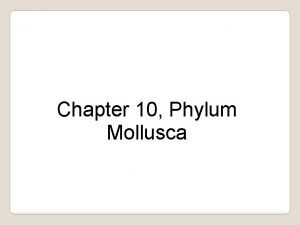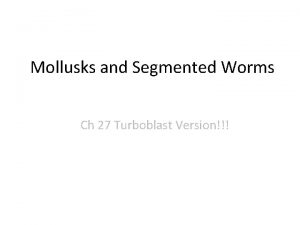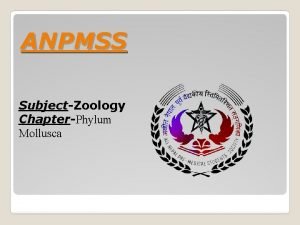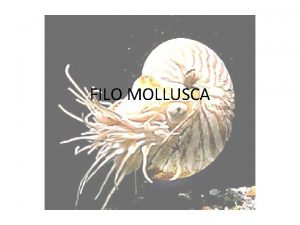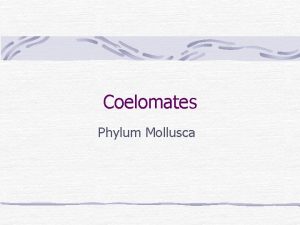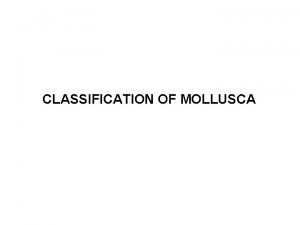V CLASSIFICATION OF Mollusca Dr M DEIVANAYAKI Mollusca










- Slides: 10

V- CLASSIFICATION OF Mollusca Dr. M. DEIVANAYAKI

• • • • • Mollusca Characteristics The organisms belonging to phylum Mollusca exhibit the following characteristics: They are mostly found in marine and freshwater. Very few are terrestrial and found in moist soil. They exhibit organ system level of organization. Their body has a cavity. The body is divided into head, visceral mass, muscular foot and mantle. The head comprises of tentacles and compound eyes. The body is covered by a calcareous shell. The muscular foot helps in locomotion. They have a well-developed digestive system, the radula is the rasping organ for feeding. They respire through the general body surface, gills or pulmonary sac. The blood circulates through the open circulatory system. They have a pair of metanephridia that helps in excretion. The nervous system consists of number of paired ganglia and nerves. The tentacles, eyes, osphradium, and statocysts act as the sensory organs. The sexes are separate in most of the molluscs but some species are hermaphrodites. Fertilization may be external or internal. They are generally oviparous with indirect development.






Classification of Mollusca Following are the classification of Mollusca: Aplacophora or Solenogasters The body is cylindrical or bilaterally symmetrical. These are devoid of the head, shell, mantel, nephridia, and foot. The digestive ceca is absent. Spicule-bearing cuticle covers the body. It contains a dorsal longitudinal keel or crest. E. g. Neomenia, Chaetoderma Monoplacophora The body is bilaterally symmetrical. The head is devoid of eyes and tentacles. Respiration occurs through gills which are externally located. The nitrogenous waste is excreted out through nephridia. E. g. Neopilina Polyplacophora Their body is dorsoventrally flattened like a leaf, and are bilaterally symmetrical. The shell is composed of 8 longitudinal plates. They have a well-developed radula. The ventral foot is flat. E. g. Chiton, Cryptochiton.

Gastropoda They are found either on land or in fresh and marine water. The head bears tentacles, eyes, and a mouth. The shell is spiral in shape. The foot is flat and large. E. g. Haliotis, Pila Scaphopoda Found in the marine environment. The eyes and tentacles are absent. The foot is reduced. The body is bilaterally symmetrical. Pelecypoda They reside in aquatic habitats. The body is bilaterally symmetrical and compressed laterally. The body has no distinct head. They usually burrow in mud and sand. E. g. Mussels, Unio Cephalopoda They are mostly found in the marine environment. The shell is either external, internal, or not present at all. They have separate sexes. The development is direct. E. g. Octopus, Spirula

Mollusca Examples Following are a few examples of the animals belonging to phylum Mollusca: Pila (Apple snail) Limax (Slug) Unio (Freshwater mussel) Turbinella (Shankha) Helix (Garden snail) Octopus (Devilfish) Loligo (Squid) Key Points on Mollusca Phylum Mollusca is the second largest phylum. A few molluscs such as Unio possess green glands which mimic the liver in vertebrates. They possess osphradia to test the chemical nature of water. The statocysts maintain body equilibrium. Octopus has 8 arms and contains no shell. They also possess ink glands for protection. The blood is blue or green in colour due to the presence of a pigment containing copper called haemocyanin. They possess a myogenic heart.
